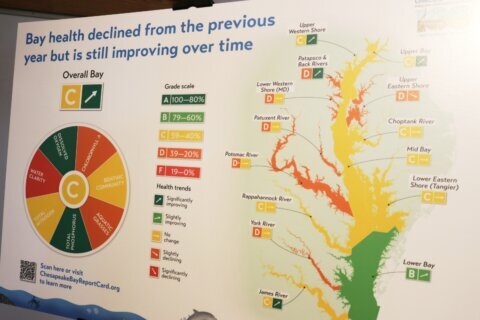WASHINGTON — Swift streams, babbling brooks and rushing rivers may not be as pretty as they look, because when environmentalists tested natural bodies of water in five Maryland counties, what they found is yucky.
“The problem is that there’s excrement in the streams and the rivers where we sometimes swim, kayak and recreate,” said Tom Zolper, assistant media director for the Chesapeake Bay Foundation.
Waterways were checked in Baltimore, Carroll, Frederick, Harford and Howard counties and in the city of Baltimore. A preliminary check in some Virginia streams near Richmond found similar results.
“Bacteria levels spike after it rains sometimes to hundreds of times above safety limits set by the federal and state government,” Zolper says.
The sources include animal and human waste. Zolper says fecal matter found in rural swimming holes may have come from livestock manure washed into a stream. Suburban streams can be fouled by pet waste the rain swept from a sidewalk. There are also septic tank leaks and Baltimore has a major and costly project underway repairing leaking sewer pipes.
“So, when you’re swimming or coming into contact with that water, it’s more like toilet water than clean, healthy stream water,” Zolper says.
Some of the worst offenders, according to a statement by the Chesapeake Bay Foundation:
- White Marsh Run, in Baltimore County, which had bacteria levels at least 400 times higher than safety standards after a rainstorm of .80 inches on Aug. 2;
- Glade Run, a rural stream in Frederick County, which was about 324 times above safety limits on June 16.
- Cascade Falls, in Patapsco Valley State Park in Howard County, had bacteria levels 304 times higher than safe standards. The foundation added that “bathers were seen in the water when the water sample was collected at the site.”
Ingesting bacteria-laced water can cause intestinal illnesses but there are precautions people can take. The foundation recommends that people avoid contact with natural bodies of water for 48 hours after heavy rainstorms. The environmentalists also say that state and local governments should take more robust steps to reduce pollution runoff into streams and rivers.
Citizens need to contact their local and state governments and leaders to insist they take more vigorous steps to reduce pollution from animals in streams, failing septic systems and polluted runoff,” Chesapeake Bay Foundation Executive Director Alison Prost said in a statement.
“Cleaning up our streams and rivers will reduce the chances of people getting sick from unhealthy water, and will provide other environmental and economic benefits. Downstream areas such as the Chesapeake Bay also will benefit.”
Meanwhile, the National Fish and Wildlife Foundation announced Thursday that they have $11 million available to support for projects in Maryland, Virginia and D.C., as well as Delaware, Pennsylvania and West Virginia, “aimed at restoring the health of the Chesapeake Bay while building community and strengthening iconic species.”
The projects are “designed to engage agricultural producers, homeowners and businesses in on-the-ground restoration actions that support quality of life in their communities, while ultimately improving the health of the Bay,” the foundation said in a statement.
See the locations where the Chesapeake Bay Foundation tested for the presence of bacteria in area streams and waterways plus find results for each site below:








